1. Prepare to fire
The gun is cocked and ready to fire, with the hollow air tube retracted just behind the next BB. The BB is held in place by a small magnet. So, even if you shoot straight down, a BB should come out. The "magazine" is nothing more than the hollow cavity formed between the inner shot tube (the true barrel) and the outer sheet metal "barrel" of the gun. When the muzzle is elevated to cock the lever, gravity pulls the BBs down against a sloped surface that has a funnel-like channel at its lowest end. The BBs are organized into a single column in this channel, and they drop down toward the BB seat where the magnet is located. All of this action depends on the muzzle being elevated, and nothing but gravity holds those BBs in place; so, they realign this way every time the gun is cocked.
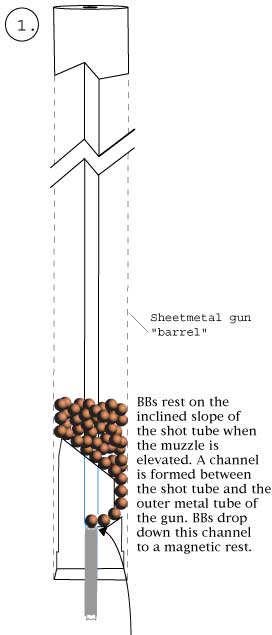
2. Gun is fired
The sear has released the piston so the mainspring drives it forward. At the same time, the air tube that projects from the center of the piston has pushed the BB off its magnetic seat and started it down the barrel. A low initial velocity is imparted by this mechanical catapulting action. This is the catapult part of the powerplant.
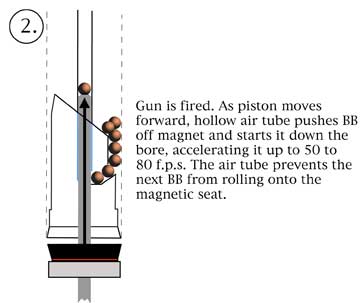
3. The compressed-air blast
The piston has slammed to a stop against the back of the shot tube, squeezing all the air from the compression chamber and through the hole at the back of the air tube. The air is now highly compressed and travels up the air tube, where it exits behind the BB that is already in motion. It imparts a boost of velocity to the BB, accelerating it to its terminal velocity. This is the spring-piston part of the powerplant.
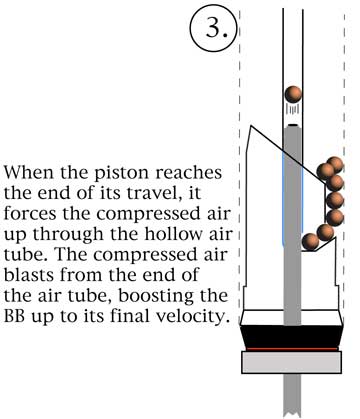
4. Gun is cocked
Cocking withdraws the piston and air tube assembly, making room for a BB to roll down and be captured by the magnetic seat. The gun is now ready to fire again.
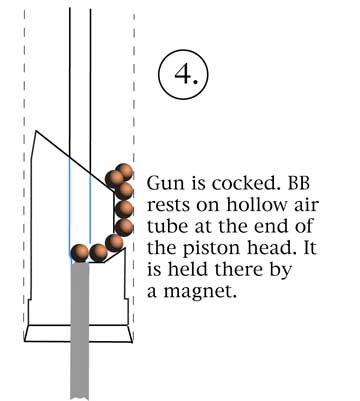
That's the cycle of the BB gun powerplant. As you now can see, it relies on both a catapult action and a spring piston to do its job. The combination of these two forces works like the booster rockets in a space vehicle; only in this instance, the boost means that the mainspring can be made light enough for younger folks to cock, yet still supply adequate power to launch a BB.

Spring & piston assembly: The mainspring is held captive by the piston assembly. A spring anchor in the gun holds the back of the spring steady when the cocking lever withdraws the piston and compresses the spring. Notice the long air tube that projects from the front of the black piston seal on the right. It fits inside the shot tube assembly, where it aligns with the barrel.
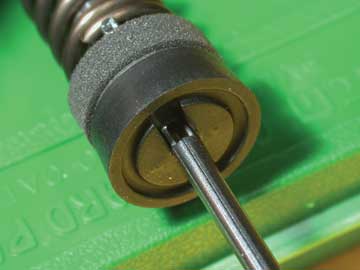
Piston detail: The genius of the design is the small hole at the base of the air tube. When the piston slams against the rear of the shot tube, all the air in between is driven through this hole and up the air tube to exit behind the BB. By that time, the air tube has already accelerated the BB to a low velocity in the barrel, and the compressed air acts as a booster.

Shot tube: The shot tube consists of the real barrel (the outside sheet metal "barrel" is for looks as well as forming the outside wall of the BB magazine) and the part of the magazine that organizes BBs and sends them back to the magnetic seat one at a time to be shot from the gun. The slope of the back part of the shot tube makes BBs fall toward the alignment channel every time the gun is cocked.
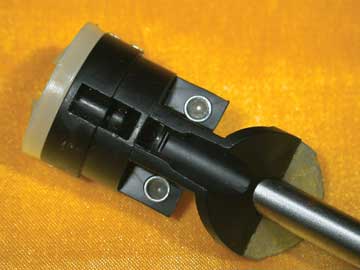
Shot tube detail: This shows how the gravity-feed mechanism works. The oval cross-section at the rear of the shot tube forms a perfectly round floor inside the BB magazine. The floor slants down to an organizing channel, where BBs are sorted into a single stack. At the bottom of the channel, a hole in the shot tube lets one BB fall onto a magnetic seat when the air tube is withdrawn during cocking. This organization of BBs occurs every time the muzzle is elevated during cocking. The white synthetic seal at the back of the shot tube mates with the piston seal to cushion it when it comes forward. Though this is a modern version of the mechanism, it has worked essentially the same way for about a century.
There are other types of BB gun powerplants, of course. Some are common, like the CO2 guns that simply blast the BB out the barrel, but others are very subtle, but the one we looked at here is by far the most common and most important type of powerplant there is.
Buy With Confidence
Get FREE shipping on qualifying orders! Any order $150+ with a shipping address in the contiguous US will receive the option for free ground shipping on items sold & shipped by Pyramyd AIR during checkout. Certain restrictions apply.
Free shipping may not be combined with a coupon unless stated otherwise.
View Shipping Info
We work hard to get all orders placed by 12 pm EST out the door within 24 hours on weekdays
because we know how excited you are to receive your order.
Weekends and holiday shipping times will vary.
During busy holidays, we step our efforts to ship all orders as fast as possible,
but you may experience an additional 1-2 day delay before your order ships.
This may also happen if you change your order during processing.
View Shipping Times
It's important to know that due to state and local laws, there are certain restrictions for various products. It's up to you to research and comply with the laws in your state, county, and city. If you live in a state or city with regulations, you may be able to take advantage of our special FFL program.
U.S. federal law requires that all airsoft products be sold with a 1/4-inch blaze orange muzzle or an orange flash hider to avoid being mistaken for regulated products.
View Shipping Restrictions
Get the most out of your equipment when you work with the expert technicians at Pyramyd AIR. With over 25 years of combined experience, we offer a range of comprehensive in-house services tailored to kickstart your next adventure.
We can test and adjust your equipment in our Pro Shop before shipping, so you receive a product that's ready to perform right out of the box. We can even set up an optic or other equipment so you can get out shooting without the hassle. For bowhunters, our certified master bow technicians provide services such as assembly, optics zeroing, and full equipment setup, which can maximize the potential of your purchase.
By leveraging our expertise and precision, we ensure that your equipment is finely tuned to meet your specific needs and get you ready for your outdoor pursuits. So look out for our services when shopping for something new, and let our experts help you get the most from your outdoor adventures.
View Service Info
Shop and purchase with confidence knowing that all of our products (except airsoft) are protected
by a minimum 1-year manufacturer's warranty from the date of purchase unless otherwise noted on the product page.
A warranty is provided by each manufacturer to ensure that your product is free of defect in both materials and workmanship.
View Warranty Details
Didn't get what you wanted or have a problem? We understand that sometimes things aren't right and our team is serious about resolving these issues quickly. We can often help you fix small to medium issues over the phone or email.
If you need to return an item please read our return policy.
Learn About Returns
Get FREE shipping on qualifying orders! Any order $150+ with a shipping address in the contiguous US will receive the option for free ground shipping on items sold & shipped by Pyramyd AIR during checkout. Certain restrictions apply.
Free shipping may not be combined with a coupon unless stated otherwise.
View Shipping Info
Want More?
Join Our Email List for News and Deals!
Join the Pyramyd AIR mailing list: Our e-mails are filled with new products, deals, sneak peeks, tips and tricks, contests and more - sign up today!
Text JOIN to 91256 and get $10 OFF Your Next $50+ Order!
* By providing your number above, you agree to receive recurring autodialed marketing text msgs (e.g. cart reminders) to the mobile number used at opt-in from Pyramyd AIR on 91256. Reply with birthday MM/DD/YYYY to verify legal age of 21+ in order to receive texts. Consent is not a condition of purchase. Msg frequency may vary. Msg & data rates may apply. Reply HELP for help and STOP to cancel. See Terms and Conditions & Privacy Policy.